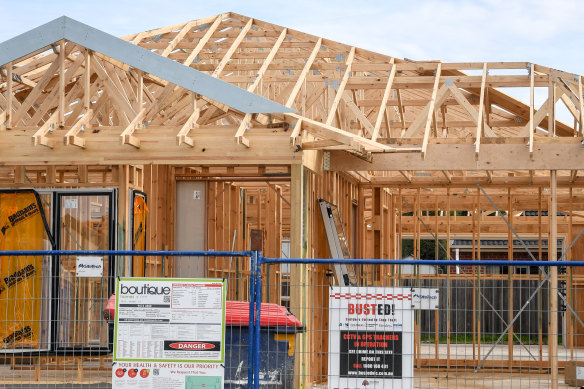This was published 3 years ago
How fear of a scare campaign brought down Labor’s social housing tax
By Josh Gordon
In the end, it was the possibility of a scare campaign heading into the state election that killed Labor’s $800 million social housing tax.
By vehemently opposing the government’s 1.75 per cent levy, the property lobby handed the state opposition the ingredients for a potent campaign targeting Labor in the suburbs over housing affordability and cost of living.

Instead of fighting for its policy, Labor has dumped the entire package of changes, ruling it out not only for this term of government but beyond.Credit: Justin McManus
The government was particularly furious about a claim by the Property Council that the levy was tantamount to a 38.8 per cent increase in stamp duty. That, the council said, would add $19,600 to the price of a new median house in metropolitan Melbourne.
For a state opposition struggling to be heard over the din created by the pandemic and federal politics, it presented a rare opportunity: it hit Labor at a crucial point in the political cycle over an issue with which many voters would identify.
Labor made a snap political judgment to cauterise the wound. Instead of fighting for its policy, it dumped the entire package of changes, ruling it out not only for this term of government but beyond.
As Treasurer Tim Pallas put it on Tuesday: “We’re not in the business of ensuring that the consumers of housing products are scared and frightened by a mischievous campaign aimed at creating fear around the cost of housing products.”
Although the decision to dump the tax package had more to do with neutralising a strategic advantage handed to the opposition, the government directed the blame squarely at the property lobby, which it accused of breaching a “grand compact” and running a campaign of misinformation by vastly overstating the impact of the tax.
According to Labor, the property sector welshed on a deal under which developers would get billions of dollars in benefits from a new streamlined planning approval process – but only if they agreed through the new tax to return a share of the “super profits” to pay for an extra 1700 social and affordable homes each year.
The reality is more nuanced. The Property Council was certainly consulted about the tax and it broadly accepted the idea that profits arising from the new planning regime would need to be partly returned to fund more social housing.
But there was never an agreement between the council and the government over the rate of 1.75 per cent. Other lobby groups, most notedly the Urban Development Institute of Australia and the Housing Industry Association, have suggested they were basically blindsided.
In other words, it is a long bow (and politically convenient) to suggest a “grand compact” existed.
The idea that the property lobby ran a campaign of misinformation about the impact it would have on housing prices is also murky.
As noted, the claim that most angered the government was that the 1.75 per cent levy – applying to projects with three or more dwellings – would add almost $20,000 to the cost of a new median Melbourne house.
By extrapolation, the figure of $20,000 assumed a house price of roughly $1.1 million. For starters, the government argues the vast bulk of house and land packages sell for well under half that amount. But more importantly, much of the tax applies at the point of subdivision, when a piece of land is carved up, making the average impost smaller again.
There were also questions over whether developers would be able to simply pass on the full amount of the tax to consumers. After all, house and land packages still need to compete with established dwellings, making it unlikely developers would shunt the entire cost burden to consumers.
However, there are plenty of instances where the tax would add $20,000 or more to prices. The notion that lobby groups representing developers and builders might draw attention to this fact is hardly shocking. Surely, it should be up to the government – not developers – to argue the case for reforms once they have been announced.
The situation is particularly distressing for Planning Minister Richard Wynne, who is retiring from politics at the next election after spending years working on the package. It provides a masterclass in how not to make the political sausage.
But the real tragedy is for the growing number of Victorians unable to find stable housing. For now, at least, it is back to the drawing board.
The Morning Edition newsletter is our guide to the day’s most important and interesting stories, analysis and insights. Sign up here.